Organisation is key in any retail business, especially when it comes to inventory management. Staying on top of your stock levels is extremely crucial and a thin line to walk on when we think about it.
That’s because being low on goods in the warehouse leads to missing sales or losing customers. Iconic companies like Ralph Lauren can testify to this as they saw their profits plummet by 50% due to lack of stock.
However having excessive stocks leads to your money being tied up, lesser liquidity, and over the charts warehousing costs.
This was evident when Nike’s stock fell through the roof due to excessive products and poor sales forecasting.
So what’s a retailer to do in such scenarios? Here’s where SKUs come as your knight in shining armour.
These codes have always helped retailers stay on top of their inventory management operations and scale their business seamlessly.
Let’s have a look at what these wondrous numbers are and how you can create them for your store.
What is SKU?
A SKU (pronounced as skew) stands for “stock keeping units” or “shelf keeping units”. It is a unique identifier used by retail companies to keep a record of all the different variants of a particular item in their inventory.
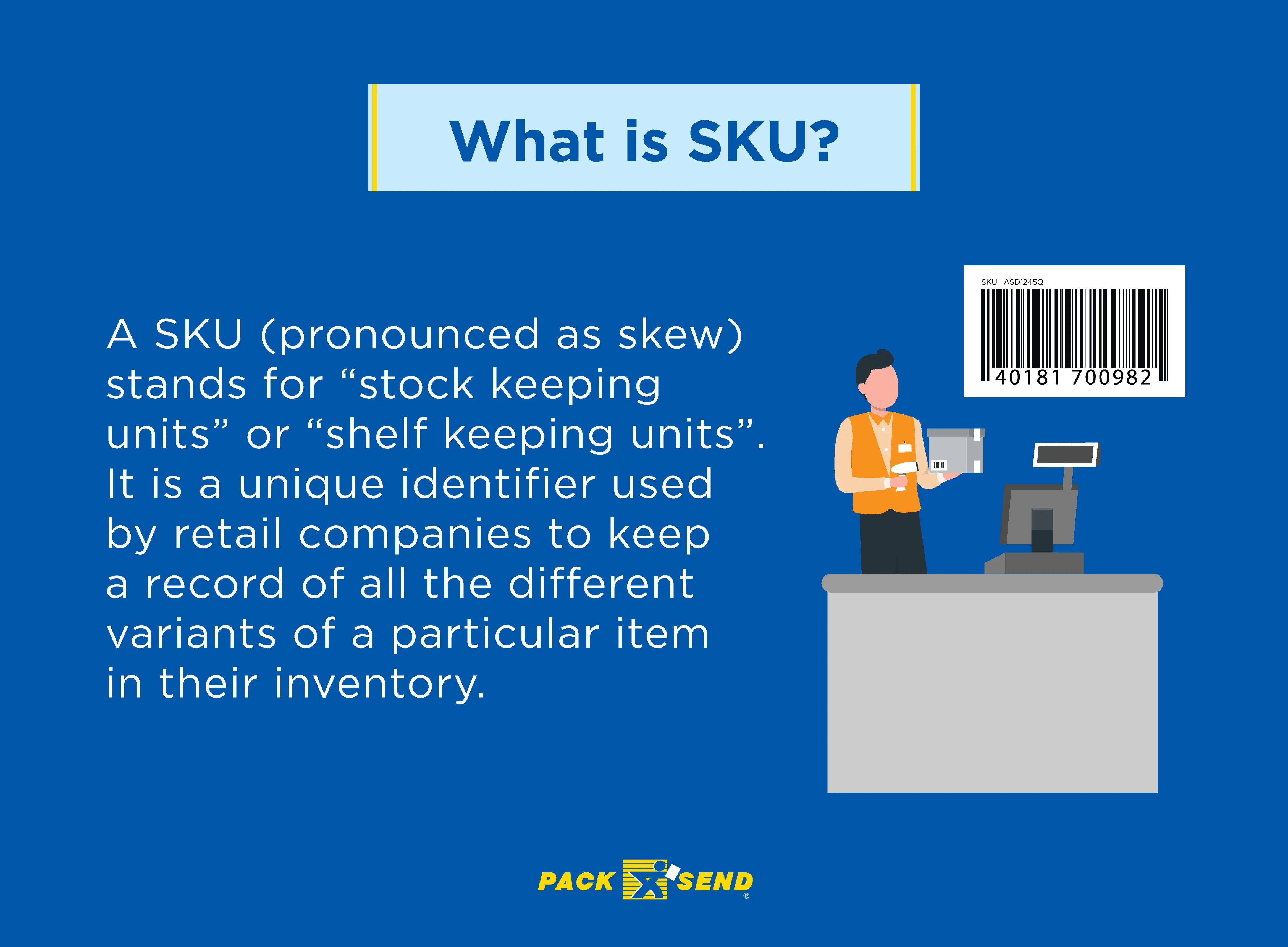
SKUs can be used to distinguish the products in your inventory based on characteristics like their manufacturer, brand, style, colour, or size.
The central aim of SKU is to help companies determine pricing strategies and efficiently account for every piece in the inventory.
What is a SKU Number?
SKU numbers are the annotated alphanumeric codes for individual numbers. Their length is somewhere around 8 to 10 characters.
The SKU numbers are not generated at random, every retail company has its own way of assigning these numbers.
Though the process is not set in stone, you should always opt for a coding system that makes it easy for you to interpret these numbers.
Normally, the data contained in a SKU number is structured in the order of most to least important information.
How Does a SKU Number Work?
Are you wondering why you need to assign new SKU numbers when the products already have a manufacturing code?
Turns out that the SKU system is just a better version of those model numbers. As we have established that SKU numbers work to differentiate one product from another in your warehouse.
It would be difficult to track sales and inventory without classifying them by make, model, type, colour, size, or any other identifying traits.
These numbers are essentially divided into three parts. The top-level identifier at the start of the number is the broadest classification a product can have.
If a company sells items for kids, for example, the category could be toys. A two or three-character alphanumeric string is then used to represent this category.
The next part is the intermediate identifier which represents a more specific product attribute.
This identifier may refer to the puzzles category within the toys section, keeping in theme with our example. The identification can be a recommended age group, difficulty level or the theme the puzzle revolves around, or another short string of letters.
The sequential identifier, that comes at the end of the SKU number, shows how an item was received and handled in order.
Beginning this part from 000 or 0000 makes it alphanumeric and simpler to keep track of the products, regardless of how many things you need to manage.
Let’s understand by looking at our example in detail. Suppose a retailer wants to come up with SKUs in order to start their inventory procedures.
They might give the letter A to toys, with A1 denoting wooden toys and A2 denoting plastic toys.
A place indicator is the next set of alphanumeric codes. B1 may therefore be assigned to outdoor toys, while B2 could be assigned to indoor toys.
The toys could then be divided further into sizes or age groups. A large 30-inch wooden cricket bat would be A1B1009, while a 32-inch wooden bat would be A1B2010 if 009 was assigned to 30-inch and 010 to 32-inch bat.
After that, the SKU is recorded into the inventory management system, which is linked to the POS system. The retailer can then use thorough reporting to track inventories and sales. Retailers can also create data on their customers, sales, and inventories using an SKU system.
How Does it Differ From a UPC or Barcode?
The universal product code (UPC) is a globally recognised product identification. Barcodes are printed images of UPCs that may be scanned using barcode scanners.
These were first used in the consumer packaged goods business to expedite checkout times.
While an SKU is utilised for internal purposes, a product's UPC code remains the same regardless of the retailer. Another major difference is that SKU numbers can have both letters and digits, but UPC codes are typically 8-12 numbers.
Internally, SKUs are created depending on what makes sense for the company. Manufacturers, on the other hand, collaborate with the Global Standard Organisation to develop UPC codes.
Finally, while SKU numbers are suggested but not required for legitimate business operations, UPCs are required to list and sell products on marketplaces like Amazon, Rakuten, and Alibaba.
Role of SKU in a Warehouse
Ultimately, how you employ SKUs is determined by the needs of your company. However, you'll have to employ them because inventory management and analysis in your warehouse, production, and storefronts are all dependent on them.
SKUs will help you and your staff build a unified language so that there is no confusion about your item's versions.
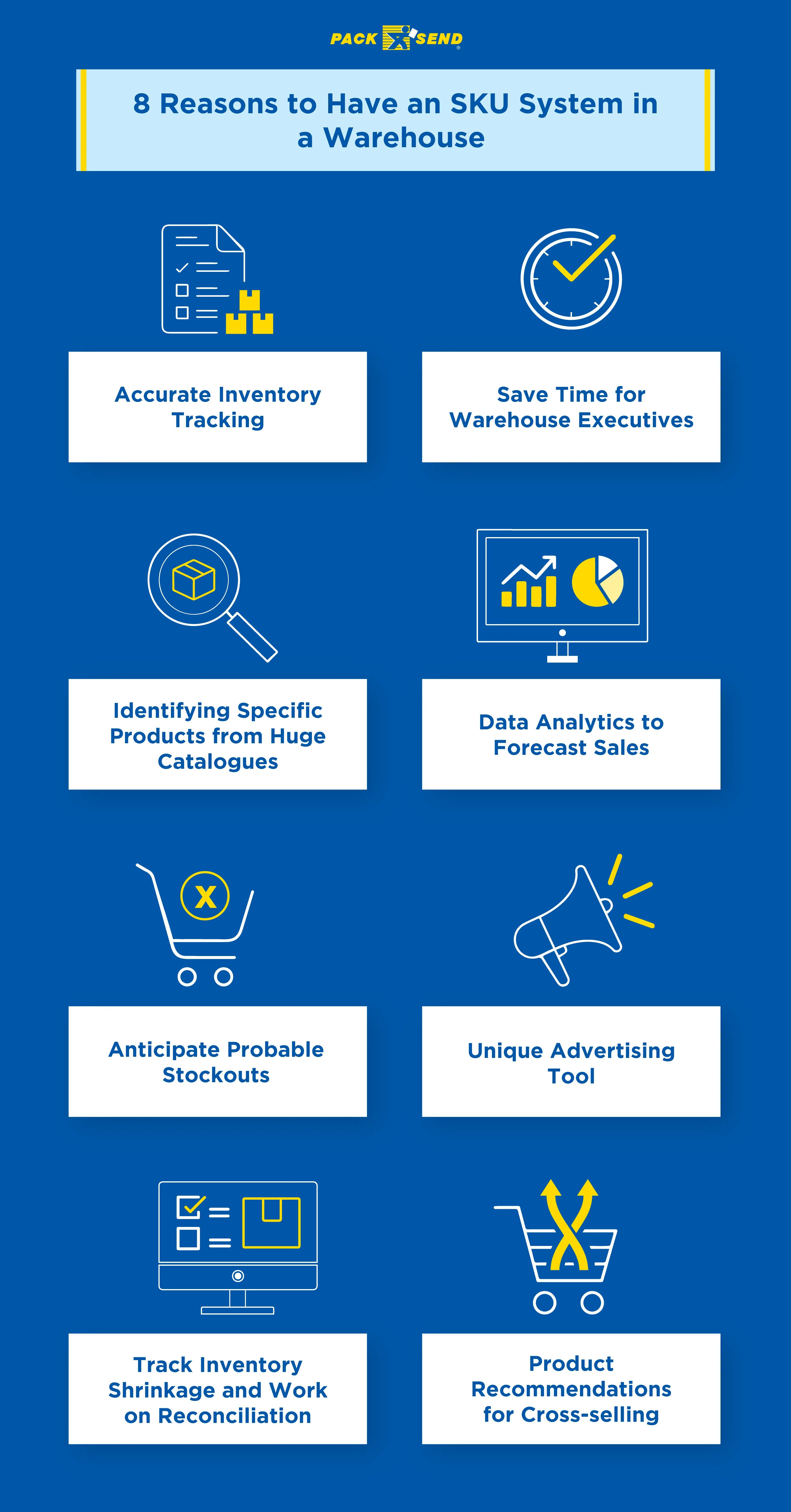
Accurate Inventory Tracking
An SKU system's primary function is inventory management. These figures aid retailers in keeping track of inventory, stock flow, and turnover.
They can define inventory levels and periods using the information received from sales, which can act as triggers for launching or stopping inventory purchases if they have accurate knowledge.
All of your inventory management efforts will be guesswork without SKU numbers. Once you've established your SKUs, you can use information like sales history to identify the ideal stock quantities for all of your items, saving you time and money in the long run.
Identifying Specific Products from Huge Catalogues
These numbers play an imperative role as and when you are scaling your retail business. When you create SKU numbers, you are providing an individual identification code for every product.
This makes it super easy to recognise any specific item from your massive product catalogue.
Imagine the efficiency of your team if they have the capability to isolate any product required within a matter of minutes by simply entering a number in the system.
Anticipate Probable Stockouts
Each and every retailer has been concerned about stockouts since the pandemic hit.
As the demand for the product hits the roof, sellers face a lot of flak due to continuous supply chain constraints. The consumers experienced a 250% rise in “out-of-stock” messages in 2021.
SKU numbers for products ensure that your store does not undergo this constant turmoil. You can easily anticipate probable stockouts.
Keeping a check on these numbers alerts your system when they run low and you get ample time to stock up. Reducing stock outs can amplify customer satisfaction by multiple folds.
Additionally, it increases your brand’s credibility and makes for a recipe to obtain loyal customers.
Track Inventory Shrinkage and Work on Reconciliation
Retailers, online as well as offline, always seem to be wary of inventory shrinkage. Such instances can occur due to a number of reasons.
A few probable causes include damage, administrative eros, stock movement, or even theft. Keeping a record of your inventory stored in the warehouse is facilitated by these unique numbers.
You may look up SKU numbers and trace the inventory shrinkage to the core issue.
Save time for Warehouse Executives
Once you create SKU numbers, you are guaranteed to free up a lot of time for the warehouse executives.
That’s because there is little need for manual inspection of the inventory. The POS system will reflect which items are selling like hotcakes and which shelves take longer to become empty.
You can also set reorder points in advance based on this information without having the employees go through the stocks ever so frequently.
Data Analytics to Forecast Sales
Keeping a dependable record and database of all your inventory through stock-keeping units aids in better prediction of the sales. In brief, you can quickly determine if things are selling well, quickly, or slowly.
With all of this information, it becomes much easier to estimate stock requirements and keep stock correctly.
After that, you must conduct a strategic product analysis. Consequently, you can take the necessary procedures to aid sales.
This data will help you remove deadstock, prioritise items, and schedule production cycles more effectively.
Your product SKUs will allow you to collect useful data on them, allowing you to analyse if the products are:
- Popular throughout the year
- In demand during a particular season
- Purchased in cyclic trends
Unique Advertising Tool
SKU numbers are also emerging as a relatively new marketing approach. With everyone comparing pricing in the competitive online retail scene, an SKU helps your inventory to appear unique and allows you to analyse marketing strategies that are driving sales based on product identifiers.
Many shops use their SKU instead of the manufacturer's model number to advertise their products.
This makes it more difficult for a customer to find the exact model in another competing store, while also reducing the likelihood of competitors mirroring pricing schemes using the same data.
It may also aid in reducing the number of consumers who visit stores to compare pricing for things they intend to purchase online.
Product Recommendations for Cross-selling
SKU codes are also used by businesses to improve customer experiences on their online sales platforms. Amazon.com, for example, can use SKUs to select things to display as "suggestions" when you shop.
Each product has been given a unique SKU with all of its identifying characteristics. When you look at a blender, the buying platform may show you other blenders that are similar.
Step by Step Process to Create SKU Numbers in Minutes
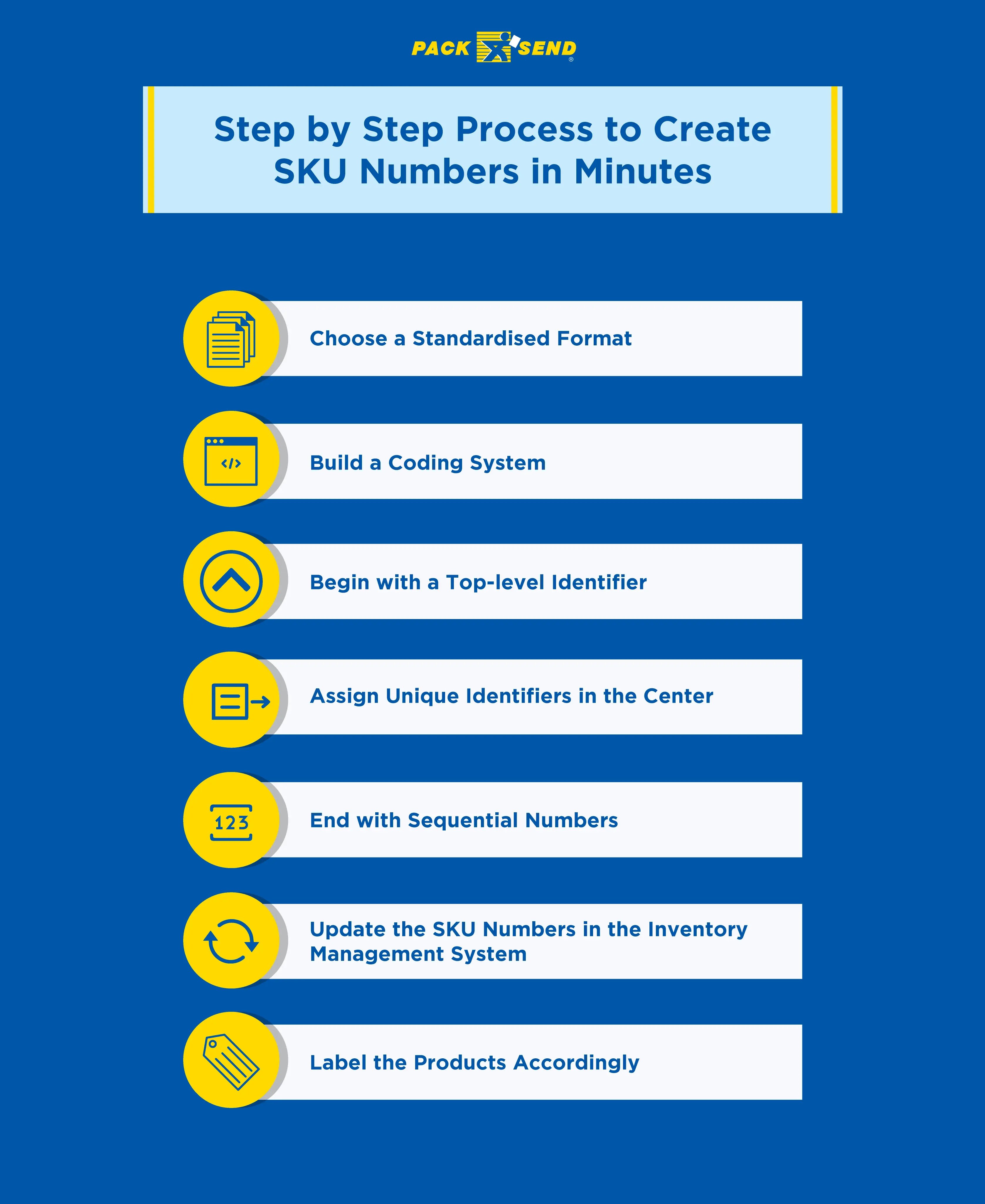
1. Choose a Standardised Format
Establish a uniform format whether you use an SKU generator or a manual procedure. If you have codes within your SKU that are misread, the interpretation of your SKU numbers will never be questioned.
Starting with the highest or most important product information first and ending with codes applicable to product variant possibilities is the ideal strategy.
Alternatives with numerous variations should come last, while those with limited options (such as gender) should come first – but after the product category and kind.
Once you've established a standard format, use it to generate SKUs. When your teams are seeking to match an SKU to the product they are picking or shipping, this makes it simple for them to comprehend what each code means.
Limit the number of code sets you provide in your SKU in order to keep it brief and avoid overloading it. Only enough information is required to identify the precise product variation.
2. Build a Coding System
Next, you need to set up a coding system. While randomly generated numbers can lead to unique SKU numbers, they can make SKU reference problematic afterwards when evaluating data or adding SKUs to variations within a product set.
Make a code that applies to important item properties and product types. These are commonly used shorthand for every iteration of a brand, product type, category, attribute, and so on.
This coding scheme, combined with a uniform structure, ensures that your SKU numbers are always understandable, regardless of who looks at them.
Once you've built a coding system, make it available to your team for reference and make it a part of all of your employees' training - not just those who handle and ship your products in the warehouse.
Just be careful not to complicate the SKU numbers for products. If at all feasible, keep each code to two alphanumerics.
3. Begin With a Top-level Identifier
A top-level identification should be represented by the first two or three digits/characters of each SKU. This could be a store category, a department, or even a supplier.
An SKU number can be used to determine the top-level merchandising group and location of any product in your shop.
If you have multiple stores, you may use this area to specify their locations.
4. Assign Unique Identifiers in the Center
Use the middle region of SKU numbers to add unique qualities to your product, such as size, colour, item type, or sub-category, as needed for arranging the products you offer.
This can become the defining trait when looking for any product in your store or warehouse.
5. End with Sequential Numbers
Using sequential numbering for the final series of an SKU number, such as 001, 002, or 003, simplifies setup and helps you distinguish between older and newer goods in a product line.
Tying the final series of an SKU number to a supplier product number can be useful in some instances. Again, whatever makes sense for the things you sell should be used.
6. Update the SKU Numbers in the Inventory Management System
You can create SKU numbers and maintain inventory by hand in notebooks or spreadsheets, but using a retail POS with inventory tracking is significantly easier and more efficient.
A POS, in general, allows you to track as much or as little product data as you desire.
To get started, most small businesses only need to enter the following information:
- Product Description that includes its name and category
- Cost
- SKU number
- Any relevant modifications, such as different sizes or colours
With this information in hand, you can quickly manage your sales and inventories in one simplified system.
Furthermore, every transaction updates your inventory, ensuring that you always know how much of each SKU number you have on hand.
7. Label the Products Accordingly
You'll want to produce scannable versions of your SKU numbers to include on your product labels for fast checkout and inventory counting once you've entered them into your inventory system.
You may make scannable codes with a barcode generator, which you can then download and print.
If you're utilising an automated inventory management software or POS system, barcodes should have been generated automatically for each of your products.
All that's left is to print your barcodes and adhere them to your merchandise.
Benefits of SKU numbers
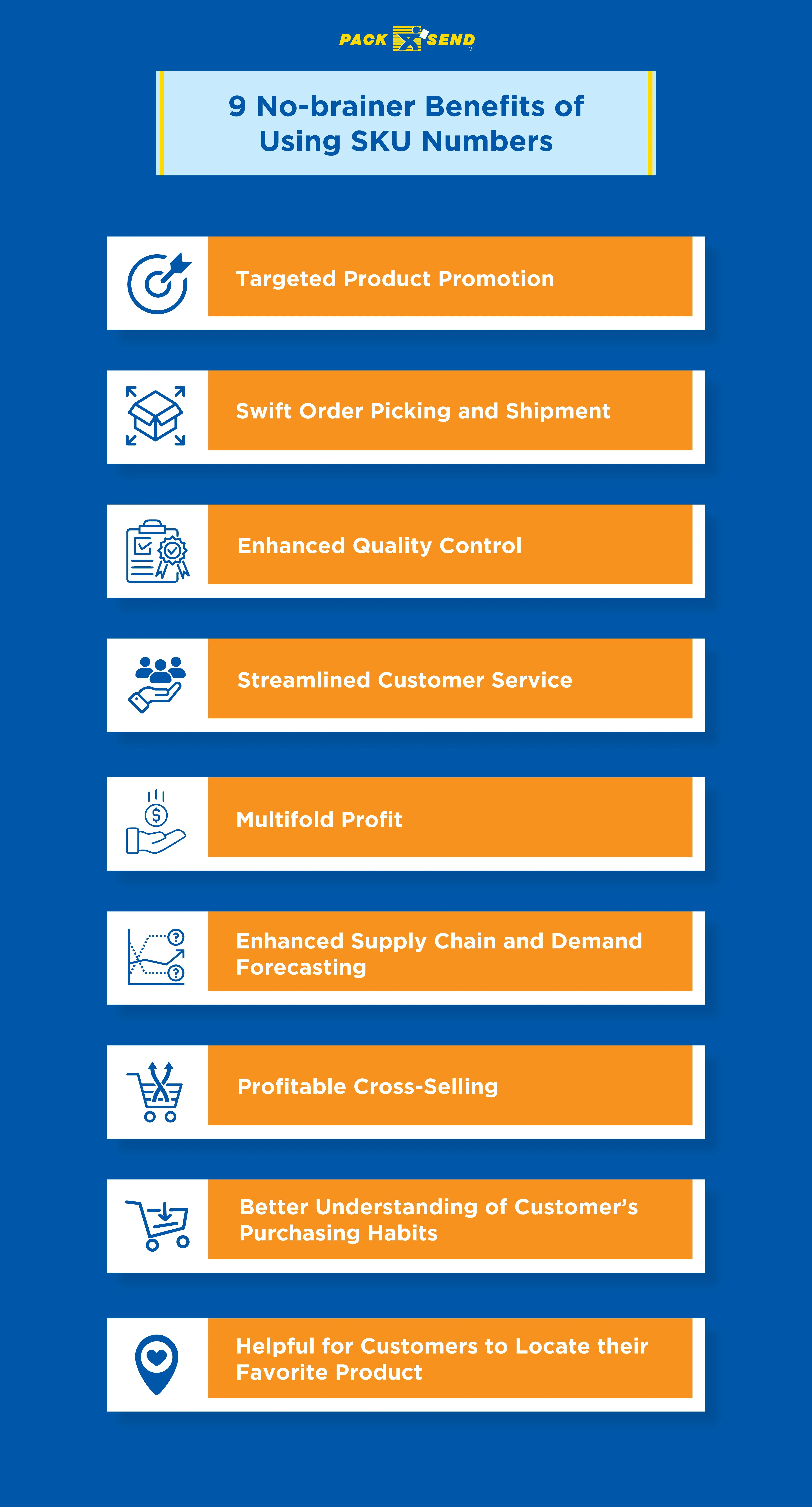
Targeted Product Promotion
It's tremendously easy to focus on product-specific promotion by analysing data on how SKUs are moving. You can design campaigns and bespoke landing pages to highlight the largest profit generators once you've identified them.
To boost targeted traffic, you may also feature those products on high-traffic pages where shoppers can quickly locate them.
Swift Order Picking and Shipment
A timely shipment is critical when an order has been placed. As a result, inventory management becomes an integral operation. However, SKU numbers make this very straightforward.
They assist warehouses in swiftly locating the desired items. Furthermore, warehouse workers can locate a particular product with pinpoint accuracy. Meanwhile, products with different versions can be quickly categorised and stored in the warehouse using SKUs.
Above all, the database may be searched whenever a specific product is required, and the exact location of the product can be determined.
In turn, discovering products in large warehouses is simplified, and orders are shipped as promptly as feasible.
Enhanced Quality Control
SKUs are also the preferred method as they help the eCommerce store owners get a better grip on the quality of their stock. Creating SKU numbers diminishes the possibility of human errors.
This is deemed profitable for your store as you end up with happier and satisfied customers who receive the order accurately, in perfect condition every time they purchase from your online store.
Streamlined Customer Service
Customer assistance and checkout are made easier and more error-free with a simplified SKU system. Using SKU numbers to track products in a POS system ensures that your inventory and pricing are always accurate.
Purchases ring up with the correct pricing when clients check out, and your on-hand inventory is instantly decreased to reflect sold items. In addition, if a customer can't identify an item, an SKU search in your POS can instantly disclose stock status and assist employees in quickly finding it and closing the deal.
Multifold Profit
Keeping track of your stock unit numbers might help you maximise your revenues. They also assist you in determining which products are the most popular. To maintain sales levels, you must take strategic activities.
It is possible to arrange products correctly on both physical and online platforms in order to increase client focus. SKUs then assist in providing 'related product' ideas while making sales.
Product recommendations aid in increasing sales and, as a result, profitability.
Enhanced Supply Chain and Demand Forecasting
Keeping track of your stock unit numbers might help you maximise your revenues.
They also assist you in determining which products are the most popular. To maintain sales levels, you must take strategic activities through such demand forecasting.
It is possible to arrange products correctly on both physical and online platforms in order to increase client focus.
SKU numbers then assist in providing 'related product' ideas while making sales. Product recommendations aid in increasing sales and, as a result, profitability.
Retailers are losing more and more inventory due to theft and inventory management problems each year.
While theft is a concern, many of these losses are the result of administrative and data entry errors, which can build up over time and have a significant impact on your bottom line.
Profitable Cross-Selling
In a competitive environment where new clients are becoming increasingly difficult to acquire, cross-selling is a critical technique for maximising sales possibilities and driving higher transaction values.
SKU numbers won't just improve your bottom line by making value-added suggestions that enhance a customer's existing product selections; such smarter selling techniques also
- Significantly decrease eCommerce order fulfilment costs by deterring single-item purchases
- Assist your company in coordinating more cost-effective packing and shipping strategies
Better Understanding of Customer’s Purchasing Habits
It becomes considerably easier to forecast sales when each product and its variations have a designated, unique SKU.
Forecasting is a must if you want to satisfy client needs, and it's also a necessary step to avoid running out of popular products during holidays or promotional seasons.
Customers may look for a substitute if they can't locate the goods they seek. In the worst-case scenario, they locate the product at a different retailer.
In fact, when faced with a stock-out, 7% to 25% of shoppers will continue browsing but will not buy a substitute for their desired item at the store whereas 21% to 43% will go to another retailer to find the item.
If you don't use an SKU generator and an organised method to estimate inventory demands, you could end up losing nearly half of your planned purchases because you're out of stock.
For a typical retailer, these abandoned purchases result in sales losses of roughly 4%.
Helpful for Customers to Locate their Favorite Product
In the eCommerce era, convenience is the key to a shopper's heart. Nothing gets them excited as much as fast checkouts, easy payment modes, or an utterly seamless website store.
Now, SKUs step in as the best way to introduce thorough categorisation of your products in the store. What’s more, your customers can place repeat orders of their favourite products just by searching for the SKU in the store.
SKU numbers for products are also necessary as they are unique to your store and the customer will not be able to find them easily on the competitor’s website.
All in all, they are a big help to the customers when shopping for products on your website and they end up having a delightful shopping experience.
Best Practices for SKU Management

By now, creating SKU numbers for products may definitely seem like an easy task that can be performed within minutes. However, it is best to adhere to the following best practices to ensure that you make the most of this coding system.
Adopt Automated SKU Number Generators
A SKU generator streamlines the procedure. While manually creating SKUs may be convenient when you're a small business, it's not a scalable procedure. Not for corporate brands with a quickly expanding catalogue, at least.
Consider employing a 3PL service provider and using their free SKU generator that can read your product options and quickly generate logical SKUs for you if you can't locate tools to help with SKU generation.
To help ease the SKU generation process, you can use a spreadsheet with formulas.
Keep Them Short and Simple
It's tempting to incorporate too much information in SKU numbers because they're so easy to modify for your business.
Choose two to three features that you wish to express in your SKU number system to avoid having extremely long SKUs. Keep the individual codes short if you want more than three features.
Highlight Important Product Traits
Decide which of the high-priority features is most important to you and place it at the start of each SKU number.
Some shops like to start with the most general attribute and work down from there, such as starting with the identifier for jeans before moving on to style and size.
Train Your Employees
SKUs have the primary benefit of reducing and simplifying daily tasks. As a result, you should make SKU training a priority for all workers — both seasoned and new.
You are sorted when everyone on your team knows how to find, read, manage, and update SKUs.
Pickers and packers can inform office workers about important developments, and vice versa.
Practices You Should Steer Clear of
While most retailers can grasp this practice after a period of time, there are a few who repeat some common mistakes every single time.
These mistakes can cost a lot of time, money or other resources to rectify. Therefore, it is best to stay away from the following errors while you create SKU numbers for your products.
Adding Special Characters
Special characters should never be used outside of formulas since spreadsheets do not recognise them.
They also add a layer of complexity to your naming standards, and they can typically be replaced with a different number or letter.
If you absolutely must use a non-alphanumeric character, use the en dash (hyphen).
Using Letters That Look Like numbers
It can be irresistible to use all of the letters of the alphabet because SKU numbers are alphanumeric.
To minimise confusion, you should avoid employing letters that look like numerals. For example, the letter "O" can be mistaken for a zero, whereas a capital "I" resembles a one.
Making Them Complicated
SKUs make it easier to make sense of data while also speeding up the process for your employees who spend their days stocking, choosing, packing, and shipping merchandise.
This is why developing an uncomplicated coding system and format that everyone can comprehend is critical.
Remember that SKU data must be interpreted by more than simply your warehouse staff. When assisting consumers, your customer service team will undoubtedly need to cross-reference this data.
Alongside, your marketing team needs these numbers for data analysis and establishing product-specific discounts within your eCommerce platform.
When examining big data sets, an easily readable SKU number may be quickly sorted and found among spreadsheets full of data, as well as simply filtered.
Starting SKU Number With 0
Zero at the start of a number is frequently misinterpreted by computer software as nothing.
As a result, the SKU 01210001N could be misread as 1210001N. Avoid starting any of your SKU numbers with a zero to avoid misunderstanding caused by this type of issue.
Many firms get around this by starting the SKU number with a brand or supplier identity.
Reusing Manufacturer’s Codes
Don't only use the numbers from the manufacturer. It may appear easier to simply use the manufacturer's number or include it in the SKU when developing an SKU number scheme.
However, having a custom SKU formula designed to meet your company's specific demands is no longer an option — it is a necessity.
Top 9 Free SKU Number Generators in 2022
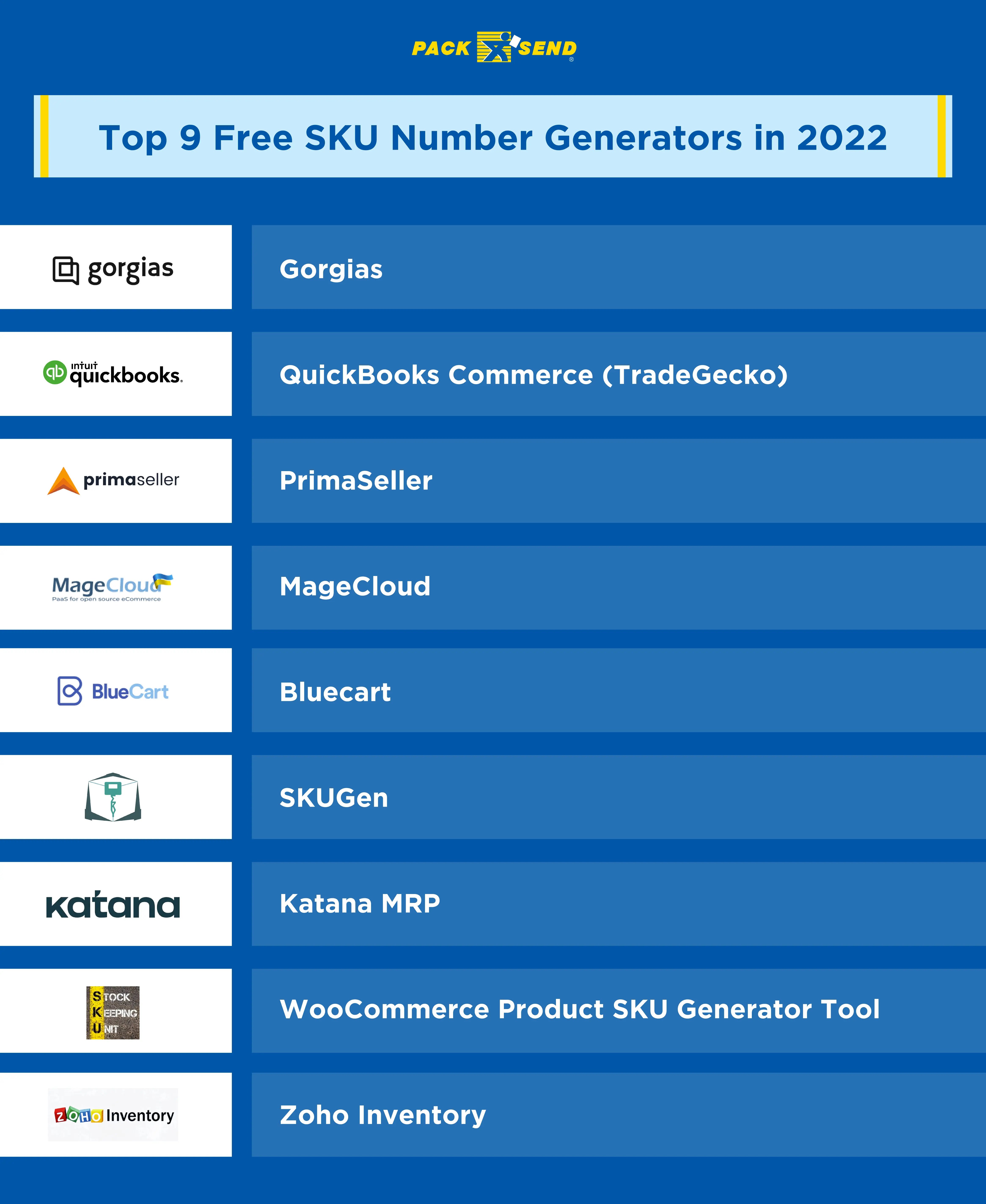
Creating your own SKUs is just one of many steps that will provide you with more control over inventory management. You may get as detailed as you want, making inventory tracking much faster and easier.
SKU generation becomes tedious when you have more than a few dozen things to go through.
An online SKU generator is significantly easier than manually constructing each SKU. Some of the best free SKU number generators are listed below:
1. Gorgias
You can use Gorgias for free to create SKU numbers. It will ask for your email address in order to set you up, and then you are ready to go! The website's design is straightforward and user-friendly.
It is not necessary to be an SKU specialist to utilise this software to generate their SKU. Gorgias is a solid platform for creating SKUs.
This tool is really simple to use; simply go to the website and begin creating SKUs from the comfort of your own home. It's also accessible as an app for on-the-go use.
2. QuickBooks Commerce (TradeGecko)
Quickbooks commerce, previously known as TradeGecko, is also a great Sku generator tool. It is a free tool that works efficiently to assign unique SKU numbers to all your product variants in minutes.
You may opt for this tool if you want to establish solid stock transparency. It also facilitates inventory management by tracking inventory levels, creating reorder points, and determining when a new purchase order is required.
3. PrimaSeller
This product management software provider provides a CSV file that can be converted into an SKU sheet. After you've downloaded the template, fill in your SKU information and upload your CSV file to their website again. Primaseller will then generate a new sheet with your SKU numbers arranged in the order you specified.
4. MageCloud
The application produces SKUs for various products that are produced physically through Magento's administration. The addon is designed specifically for stores that do not have fixed SKUs from their external suppliers. There are two types of editions: enterprise and community.
5. Bluecart
They provide a free and straightforward SKU generating template for Excel or Google Sheets. Simply enter your product specifications and the sheet will do the rest.
You can explore the options provided by Bluecart for fool-proof SKU generation in minutes.
6. SKUGen
SKUgen is a free SKU-generating programme that you may download from the internet. It is available for download from the website stated above. It moves at a breakneck speed, and its consistency delights clients.
It creates SKU numbers for products based on your choices and the rules you set. You can create SKUs and barcodes for all of your products or just a subset of them.
It has over eight different functions to choose from, making it quite versatile.
7. Katana MRP
Katana is a website that generates SKUs for you and offers you SKU templates so you can quickly curate your own SKUs for your products.
The website is easy to navigate, and the plan is described in great detail to avoid any misunderstandings.
The majority of individuals are unfamiliar with the process of creating SKU numbers, therefore they are relieved to discover everything described in great detail.
All you have to do now is go to the website and follow the steps to produce SKU tags for your products.
8. WooCommerce Product SKU Generator Tool
When products are enabled for publishing or updates, this tool requires WooCommerce 3.0.9 or higher to generate SKUs for different products, variations, or both.
SKUs for external or parent products can be created using the product's slug or ID. A product with the slug wp-formal-shirts, for example, may have an SKU of wp-formal-shirts or 365 depending on the product ID.
When the product or item is enabled, this SKU will be produced.
If the product is variable, the plugin can design and produce SKU numbers for the product variations automatically if necessary.
Attribute slugs or variation IDs for each variation can be attached to the parent SKU through variation SKUs.
9. Zoho Inventory
The SKU generating tool on Zoho Inventory is another reliable SKU generator. The application is free to use.
You'll need to go to the company's website to acquire access. It has a straightforward and easy-to-use layout.
On its website, Zoho Inventory also features a multitude of additional free products.
The SKU generator makes it simple to create SKU numbers for your goods. You can keep track of your stock and sales with Zoho Inventory.
In a Nutshell
SKU numbers can turn out to be an amazingly useful tool in your commerce. By assigning individualistic identifiers to your huge catalogue of products you can make smarter retailing decisions and stay on top of your inventory at any time.
The major advantage is that they are also really easy to create. You can use a plethora of free templates of SKU generators to create a standardised system efficiently.
You can keep track of your inventory and make better retailing decisions by converting your products into numbers. You can also make your floor staff's lives easier. SKUs are a win-win situation.
Frequently Asked Questions
What are SKU numbers?
SKU is an abbreviation for Stock Keeping Unit. It's an 8-12 character alphanumeric code that differentiates one product variety from all others in your warehouse. This one-of-a-kind internal code helps store owners keep track of their inventory.
The uniqueness of an SKU is its strength. Your SKU designations might be influenced by your customers' demands and questions.
Because it's unique to your company, you may adjust the code to the most common questions customers or vendors have about your product.
Why are SKU numbers important?
SKU numbers are essential for your store because:
- SKUs boost your company's efficiency and productivity by making operations (from sales to inventory), sorting, and searching easier at every stage of the process. Most importantly, SKUs allow you to keep track of each item in real-time.
- By reducing human errors and allowing for speedier delivery to your consumers, they improve quality control and customer happiness.
- They drastically improve your inventory management by simplifying inventory tracking and preventing backorders or shrinkage. SKUs also make stock management in multiple locations easier.
- SKUs improve your profitability by allowing you to better analyse your stock and sales, as well as improve your decision-making process.
How to create SKU numbers?
Creating SKU identifiers that are relevant to the things you sell is ultimately up to you. The codes should not be very long or complicated.
They should consist of a simple alphanumeric sequence.
The simplest way to choose these characters is to tie them to the item's specifications.
It should be simple to produce a code that represents those factors by looking at the size, colour, age, weight (or any other property).
Unless two products are identical, they should not have the same code. If two things are dissimilar in any manner, they should be given separate SKU numbers.
These codes should be known by all employees, as they are essential for the organisation's consistency.
If various departments use different SKUs for the same product, it could lead to an erroneous picture of your stock and finances (which would negatively impact overall performance).
Only use your SKU numbers within your company. Any of your partners should not utilise the same SKUs as you.
They will have their own procedures in place to keep track of this data. When a new product is added to your inventory, a common best practice is to produce a code. In this manner, the information on the new item may be tracked right away.
How to read a SKU number?
You can read your SKU by keeping your coding system handy. Initially, you may find the different codes and abbreviations a bit confusing however you will start recognising them over time.
Here’s the tl;dr — the SKU will broadly be divided into three parts. The initial 2-4 characters will depict the general category that the product falls into.
As we move ahead the codes will start reflecting characteristics specific to that product. The middle portion will help you with the niche the product falls in with its’ distinguishing traits.
Whereas the final part of the SKU number will determine which product is older and which ones have newly arrived in the warehouse.
Is SKU the same as UPC or barcode?
SKU numbers, Universal Product Codes (UPCs) and barcodes are easily confused, and it happens all the time. In many aspects, SKUs are completely different from UPCs.
A UPC is a 12-digit number that is typically associated with a barcode. This number is required for products sold through the retail supply chain and allows you to trace a product at multiple points in the supply chain.
To ensure the standards, an international agency called GS1, formerly known as the Uniform Product Code Council, produces and issues UPC codes.
UPCs are number-based and universal. Whereas SKUs are usually alphanumeric identifiers. If you’re thinking — are SKU numbers universal as well? The answer is no! They are unique to your company and to every individual product. There is no regulatory body that governs the way you can create SKU numbers.
